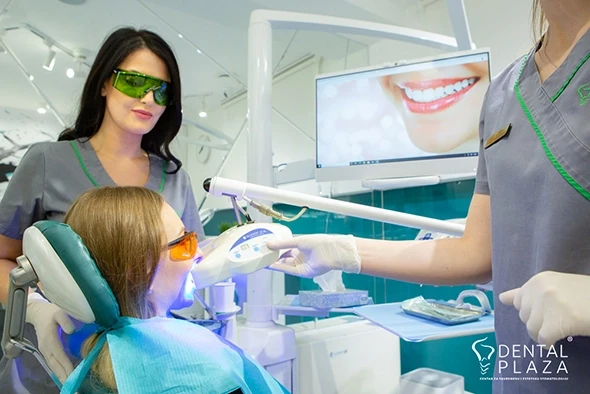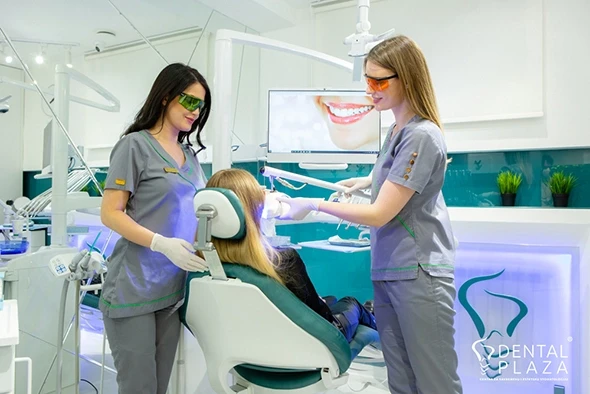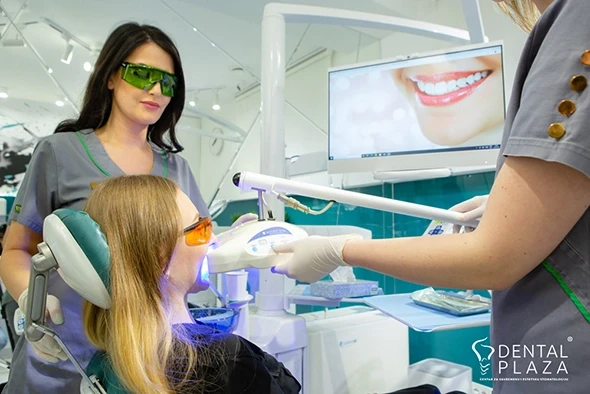Do not be shy, show your teeth!
Call Center 08-21h
Do not be shy, show your teeth!
Call Center 08-21h
The process of teeth whitening is one of the most popular treatments in modern dentistry. Laser teeth whitening involves the chemical removal of tooth pigments that become significantly whiter and lighter.

Teeth whitening is not harmful and is completely non-invasive on the teeth! Many studies have shown that withening has no negative effects if it is performed by a professional, under controlled conditions and with adequate equipment. In addition, modern gels used in this procedure are enriched with fluoride, which additionally "feeds" the teeth.
The office teeth whitening treatment lasts about 60 minutes. During that time, the whitening gel application is repeated several times and the process is controlled by the dentist.
Home whitening is a process that lasts two to four weeks when whitening gel treys are worn during the night.
The teeth whitening procedure is completely painless and comfortable for the patient. If you feel any discomfort during the whitening process, you need to tell the dentist who will determine what it is.
It is not possible to determine the exact duration of teeth whitening results. The duration of the effect depends primarily on the different habits of the patient in consuming food and drinks which may have a tendency to create pigments on the teeth. For people who consume cigarettes, coffee, teas, red wines, etc. every day, the effect after the intervention will be shorter. In addition, it is important to adequately maintain oral hygiene so that the results last as long as possible.
When it comes to dental office teeth whitening, sometimes just one treatment is enough for the desired effects. If, after one visit, the patient still wants whiter teeth, it is necessary to repeat the procedure in the next few days. The procedure can be repeated 3 times in ten days, depending on the desired whiteness on the part of the patient, and also on the initial degree of tooth discoloration.
During just one treatment of dental office teeth whitening, they become up to two to four shades lighter. This is influenced by many individual factors in each patient.
Tetracycline teeth can occur after the consumption of tetracycline in the phase of intensive growth in children, when pigments are formed that are incorporated into the tooth structure. Aesthetically, these teeth do not look beautiful, because they have gray or brown pigmentation. Slightly weaker tetracycline pigmentation can be removed by teeth whitening, however, if the pigmentation is more pronounced, the solution is not teeth whitening, but mostly making veneers.

Teeth whitening is contraindicated in pregnant women, as well as in women who are breastfeeding period.
Office teeth whitening is not conditioned by the patient's age, so it can give good results in elderly patients as well.
IT IS NOT! Gels used for dental office teeth whitening, if applied inadequately, can cause gum burns or other harmful effects. It is necessary to perform teeth whitening in dental offices where the procedure will be led by a professional!
The color of crowns and fillings cannot be changed by teeth whitening. Inadequate fillings must be changed before teeth whitening. Also, if after teeth whitening, the color of fillings or crowns does not fit with the rest of the dentition, they can be replaced in agreement with the dentist.
Teeth whitening and veneers are two different dental procedures. Veneers can be made in situations where teeth whitening cannot eliminate some pigmentation in the region of the front teeth.
After the teeth whitening procedure, it is necessary to listen to the dentist's advices on maintaining oral hygiene and avoiding stained food and drinks, so that the whitening effect lasts as long as possible. Whether the teeth will return to the initial color, primarily depends on the habits of the individual.
People who should not use teeth whitening are pregnant women, breastfeeding women, patients with uncontrolled diabetes, immunocompromised people with severe systemic diseases.
Some people may develop tooth sensitivity after a teeth whitening procedure. This discomfort is transient and disappears in a few days after the procedure.

It is not recommended to consume red wine, coffee, teas and cigarettes after teeth whitening. Their consumption in the first few days after bleaching can reduce the effects of treatment.
Dental office teeth whitening can be performed in several treatments (maximum three within ten days). If necessary, the procedure can be repeated after 6-12 months.
Teeth whitening can be repeated every 6-12 months, depending on the desired effects of the treatment.
The misconception is that bleached teeth are more susceptible to caries than unbleached ones. New whitening gels are enriched with fluorides that prevent caries and nourish teeth. Also, caries is a dental disease that primarily occurs as a result of poor oral hygiene.

Do you have questions?
The process of teeth whitening is one of the most popular treatments in modern dentistry. Laser teeth whitening involves the chemical removal of tooth pigments that become significantly whiter and lighter.

Teeth whitening is not harmful and is completely non-invasive on the teeth! Many studies have shown that withening has no negative effects if it is performed by a professional, under controlled conditions and with adequate equipment. In addition, modern gels used in this procedure are enriched with fluoride, which additionally "feeds" the teeth.
The office teeth whitening treatment lasts about 60 minutes. During that time, the whitening gel application is repeated several times and the process is controlled by the dentist.
Home whitening is a process that lasts two to four weeks when whitening gel treys are worn during the night.
The teeth whitening procedure is completely painless and comfortable for the patient. If you feel any discomfort during the whitening process, you need to tell the dentist who will determine what it is.
It is not possible to determine the exact duration of teeth whitening results. The duration of the effect depends primarily on the different habits of the patient in consuming food and drinks which may have a tendency to create pigments on the teeth. For people who consume cigarettes, coffee, teas, red wines, etc. every day, the effect after the intervention will be shorter. In addition, it is important to adequately maintain oral hygiene so that the results last as long as possible.
When it comes to dental office teeth whitening, sometimes just one treatment is enough for the desired effects. If, after one visit, the patient still wants whiter teeth, it is necessary to repeat the procedure in the next few days. The procedure can be repeated 3 times in ten days, depending on the desired whiteness on the part of the patient, and also on the initial degree of tooth discoloration.
During just one treatment of dental office teeth whitening, they become up to two to four shades lighter. This is influenced by many individual factors in each patient.
Tetracycline teeth can occur after the consumption of tetracycline in the phase of intensive growth in children, when pigments are formed that are incorporated into the tooth structure. Aesthetically, these teeth do not look beautiful, because they have gray or brown pigmentation. Slightly weaker tetracycline pigmentation can be removed by teeth whitening, however, if the pigmentation is more pronounced, the solution is not teeth whitening, but mostly making veneers.

Teeth whitening is contraindicated in pregnant women, as well as in women who are breastfeeding period.
Office teeth whitening is not conditioned by the patient's age, so it can give good results in elderly patients as well.
IT IS NOT! Gels used for dental office teeth whitening, if applied inadequately, can cause gum burns or other harmful effects. It is necessary to perform teeth whitening in dental offices where the procedure will be led by a professional!
The color of crowns and fillings cannot be changed by teeth whitening. Inadequate fillings must be changed before teeth whitening. Also, if after teeth whitening, the color of fillings or crowns does not fit with the rest of the dentition, they can be replaced in agreement with the dentist.
Teeth whitening and veneers are two different dental procedures. Veneers can be made in situations where teeth whitening cannot eliminate some pigmentation in the region of the front teeth.
After the teeth whitening procedure, it is necessary to listen to the dentist's advices on maintaining oral hygiene and avoiding stained food and drinks, so that the whitening effect lasts as long as possible. Whether the teeth will return to the initial color, primarily depends on the habits of the individual.
People who should not use teeth whitening are pregnant women, breastfeeding women, patients with uncontrolled diabetes, immunocompromised people with severe systemic diseases.
Some people may develop tooth sensitivity after a teeth whitening procedure. This discomfort is transient and disappears in a few days after the procedure.

It is not recommended to consume red wine, coffee, teas and cigarettes after teeth whitening. Their consumption in the first few days after bleaching can reduce the effects of treatment.
Dental office teeth whitening can be performed in several treatments (maximum three within ten days). If necessary, the procedure can be repeated after 6-12 months.
Teeth whitening can be repeated every 6-12 months, depending on the desired effects of the treatment.
The misconception is that bleached teeth are more susceptible to caries than unbleached ones. New whitening gels are enriched with fluorides that prevent caries and nourish teeth. Also, caries is a dental disease that primarily occurs as a result of poor oral hygiene.
